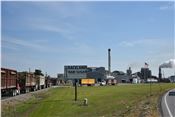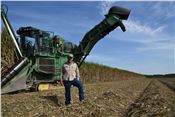2022 Sugarcane Harvest Off To A Positive Start
DEREK ALBERT
THIBODAUX, LOUISIANA
In October 2021, Jason Richard was doing exactly what he is doing this October. He was waking up at the same time before 5 a.m., climbing in the same John Deere, harvesting sugarcane in the same fields and hauling his crop to same place – the nearby Raceland Raw Sugar Corporation. But things looked a little different in Lafourche Parish 12 months ago.
On August 29, 2021, Hurricane Ida wreaked havoc with its Category 4 winds and nearly a foot of rain when it made landfall near Port Fourchon in southern Lafourche Parish, about 60 miles from where the Richards’ farm lies near St. Charles. Richard recalled evacuating with his wife, Lori, and their two children, Jase and Blair.
“I didn’t know what we were going to come back to … whether we were going to have a crop or not,” Richard said.
“The entire southeast Louisiana sugarcane industry felt the blows dealt by the hurricane,” said Renee Naquin Castro. She serves as the LSU AgCenter agronomy agent for Lafourche, Assumption, Ascension, Terrebonne, St. Charles and St. James parishes. Those parishes contain approximately 25 percent of the state's sugarcane production. Castro said this year’s harvest is shaping up to be one that is vastly different from what Richard and other farmers were seeing last year.
“The sugar industry is really resilient,” Castro said. “This year could possibly be a record year. The crop is beautiful.”
While a lot of the maturing 2021 crop was twisted, and in places, flattened, the Richards fared well, considering the magnitude of the storm. The warm, sunny September following Hurricane Ida offered plenty of sunlight to help dry the soggy soil and slowly erect the crop that was bent and tangled from the storm’s 150 mph winds.
“We didn’t have too much damage, just a few pieces of equipment,” Richard recalled. “The recovery was fairly quick.”
As the harvest progressed, Mother Nature shined on Louisiana sugarcane farmers with dry weather and sunny days that Richard said helped to create this year’s crop that, so far, is looking to provide for a bountiful sugar harvest.
“It’s a totally different crop from last year,” Richard said enthusiastically. “Last year, at the beginning, we had rain after rain after rain. Then, we had the hurricane. But we had a dry grinding, and we had a dry spring. I think that is what helped it out.”
LSU AgCenter sugarcane specialist Kenneth Gravois corroborated Richard’s sentiments about the dry 2021 harvest aiding this year’s crop.
“This crop started last year,” Gravois said. “We had a dry November and December, and that's some of the biggest weather influencers for the next year’s crop.”
“It’s a very encouraging start to the crop,” Gravois said.
“Just about everybody that I have talked to is encouraged by the tonnage and the sugar recovery. You don’t often get the best of both worlds, but this year most farmers are.”
Gravois explained that to begin each year’s harvest, farmers usually start with fields that have heavy clay soils, usually with less vigorous stands of sugarcane. This year that is no different, but even with harvesting the less productive fields, the metrics used to measure yields – tons of cane per acre and pounds of sugar per ton of cane – are promisingly higher than usual.
“When you get along the Bayou Lafourche and Mississippi River areas, those are some of the youngest alluvial soils in the U.S. They are some of the most fertile. It’s been one of the main parts of the heart of the industry for more than 200 years,” Gravois added.
Richard farms approximately 800 acres of sugarcane along Bayou Lafourche just south of Thibodaux, in the tiny St. Charles community.
He said sugarcane has been a part of his family’s livelihood for generations. He started farming full time alongside his father, Philip, in 2004 after graduating from Nicholls State University with a degree in agribusiness. As an up-and-coming farmer, he was a member of the Lafourche Parish Farm Bureau Young Farmers and Ranchers Committee.
He continues his service to the community and the industry as a member of the Lafourche-Terrebonne Soil and Water Conservation District.
Despite challenges of rising input costs and the threat of the weather taking its toll on the annual crop, Richard said sugarcane is a big part of the community and he hopes to continue the tradition as long as the operation can sustain his family – and beyond.
“I have a little boy who’s 8 years old,” Richard said speaking of his son Jase, who would represent a ninth generation of sugarcane farmers in the family. “The other day he just told me, ‘I guess I’m going to be a farmer too, Daddy.’ ”
Castro said Jason Richard, and other farmers his age represent the future viability of the industry.
“We’ve lost a lot of growers over the years,” Castro said.
“Years ago in Lafourche, we used to have a lot more farmers than we do now. It’s nice to see the younger generations taking up farming and moving forward.”
Helping the industry move forward is a main goal of the American Sugar Cane League, located about 6 miles away from the Richards’ farm, on the opposite bank of Bayou Lafourche. General Manager Jim Simon said he shares in the farmers’ enthusiasm over the positive start to this year’s harvest.
“You almost couldn’t ask for a better start,” Simon said. “We have a pretty decent crop in the field, and it has been dry. A lot has to happen between now and when the last stalk passes through the mills in January, but things are starting off good for us.”
Simon said during harvest season, the public will undoubtedly notice more trucks hauling cane on the state’s thoroughfares, along with harvesting equipment that is essential in getting the crop from the field to the mills. He urges motorists to use caution and follow the laws when approaching harvesting sites, sugar mills and slow-moving equipment.
“Be aware that farmers from all over the state — whether it’s sugarcane, rice, cotton or soybeans — we’re all bringing our crops out of the fields into market,” said Simon. “We’re asking folks to be extra cautious at this really active time of the year.”
This year, the American Sugar Cane League is celebrating real sugar by teaming up with the Sugar Association, an organization based in Washington, D.C., that touts itself as the scientific voice of the U.S. sugar industry. The groups have established National Real Sugar Day which will be celebrated on Oct. 14. Simon said the day is intended to make more consumers aware that real sugar is grown in sugarcane and sugar beet fields throughout the U.S. He said there are many ways the industry, its farmers and the general public can participate.
“Folks can prepare a real sugar recipe and post it on social media,” Simon said. “Our growers can be active on social media with posting pictures of themselves in the fields bringing sugarcane from their fields to the consumers’ tables.” ∆
DEREK ALBERT: LSU AgCenter

A queue of trucks hauling harvested sugarcane to Raceland Raw Sugar Corporation will be a common sight during the 100-day harvest that is expected to finish near the end of December in Lafourche Parish.

For Jason Richard and his fellow southeast Louisiana sugarcane farmers, high tonnage yields and good sugar recovery help to ease the pain of last year's Hurricane Ida.
Photos by Derek Albert/LSU AgCenter